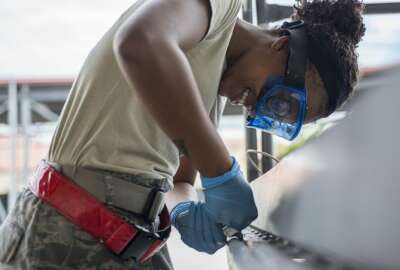Being a pilot in the Air Force is a dream for a lot of kids, but sometimes biology gets in the way. To be a pilot you need to be between 5 feet 4 inches and 6 feet 5 inches and have a sitting height of 34 inches to 40 inches.
For nearly 44% of women ages 20-29, height is a disqualifier, and for a military service putting an emphasis on diversity in its ranks, it’s a problem.
That’s why the Air Force is bolstering its waiver process for those itching to get into the cockpit, even if they may be too short or too tall, and it especially wants women to apply.
“We have tried to be as inclusive as we can, but every now and then you realize some of the things you are doing may be unintentionally not helping,” Maj. Gen. Craig Willis, commander of the 19th Air Force, told Federal News Network. “If you are on the inside everyone is familiar with the expression ‘There’s a waiver for everything,’ but you may not know there is a waiver for everything.”
The Air Force found many women were not applying to be pilots because of the height restrictions on the website.
“We have a great process for getting people through the waiver process, but we had a less good process for making sure people knew that there was a waiver process,” Willis said. “In the last couple weeks alone we’ve gone out and we’ve tried to modify the language on the website, so instead we are saying we can accommodate a wide range of heights. If you’re interested, apply.”
So, how do waivers work?
It starts with anthropometric measurements — things like sitting-eye height, butt-to-knee length and arm span. A team of experts determines if someone can still fly a plane since everyone is a little different. Some people have longer legs or longer torsos despite being the same height, and therefore can still fly. Also, not all cockpits are the same, so some people can fly certain planes, but not others.
In fact, 95% of waiver applicants over 5 foot 2 fit the standards. People as short as 4 foot 11 and as tall as 6 foot 9 have ended up flying.
The Air Force even provides special seats for shorter candidates that they can use while flying to reach the needed metrics.
The Air Force is on a mission to increase diversity in its ranks.
“The real point of all of this is if we are going to defend this country, if we are going to make the kind of decisions every single day that Americans have come to count on us to make, then we need to have the best people in the room,” Willis said. “We are going to do every single thing we can to make sure that room includes people with diverse backgrounds and different perspectives. The science proves that if you have people with different perspectives, different backgrounds and different ways of looking at the problem then you have a much better chance of getting a great solution.”
In 2017, the Air Force released 13 policies aimed at recruiting and retaining talent and diversity.
The policies require the Air Force to consider a broader range of candidates for key positions that usually lead to leadership roles, such as an aide de camp or military assistant. The policies require candidate pools for those positions must include at least one qualified person who is also considered diverse because of personal life experience, geographic or socioeconomic background, age, race or a handful of other attributes.
The Air Force also required more diversity in its command screening boards and development teams.
The policies mandated the service push its recruiting efforts out to new geographic markets and give recruiters access to better databases, technology designed to engage potential recruits and data analytic capabilities.
Copyright
© 2024 Federal News Network. All rights reserved. This website is not intended for users located within the European Economic Area.
